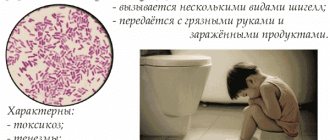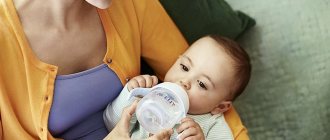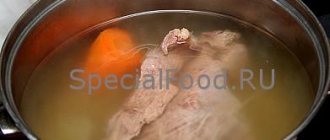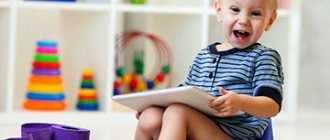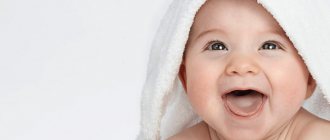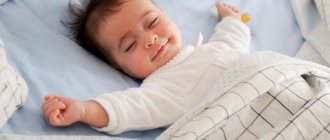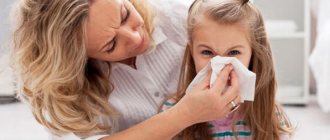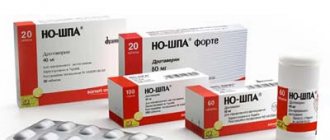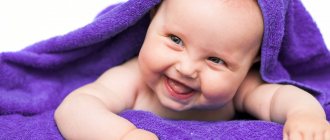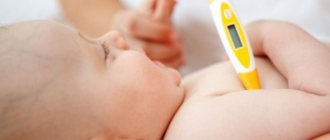Diarrhea in children, especially young children, is not only an unpleasant symptom, but also very dangerous. During diarrhea, the body loses a large amount of fluid, and with it vital vitamins and microelements. Diarrhea may be accompanied by vomiting, fever, general weakness and other associated symptoms.
If your baby experiences frequent loose stools, an urgent medical consultation is necessary to determine its causes. Depending on the causes and accompanying symptoms, treatment and appropriate nutrition will be prescribed. What kind of diet is needed for diarrhea in a child?
What can cause diarrhea?
Diet for diarrhea in a child plays a very important role
Diarrhea is not an independent disease; it can be a symptom of the following ailments:
- Dysbacteriosis
- Colitis
- Acute intestinal infection
- Food poisoning
With any of these diseases, children develop intestinal dysfunction, so nutrition that is especially gentle on the mucous membrane is necessary. The most common cause of diarrhea in childhood is food poisoning or toxic infections.
Food poisoning can occur due to the ingestion of stale foods or toxic substances. Toxic infection develops against the background of consumption of products containing microorganisms, their metabolic products, as well as living cells of the infectious agent. This disease is acute and is not transmitted by contact.
Microorganisms that enter the body under normal conditions do not reproduce; in cases where the child’s immunity is lowered, they can cause enormous harm to health. Under certain conditions, bacteria acquire pathogenic properties and can cause infectious diseases.
Can children have milk for diarrhea?
Loose stools in children are caused by poisoning, mechanical disorders of the gastrointestinal tract, and intestinal infection. In such situations, diarrhea is considered the first sign of a pathological process in the body.
Only a doctor can make the correct diagnosis. Severe loss of fluid leads to the loss of microelements and salts necessary for the development of the baby. At this moment, you need to feed your child with diarrhea dietary dishes.
The diet must be carefully selected.
Basic principles of nutrition
There are many reasons for diarrhea, as well as methods for eliminating it. However, the basic principle of proper nutrition in any situation remains easily digestible foods with the highest content of vitamins and microelements. This rule affects everyone, regardless of the child’s age and the pathology that caused the digestive disorder.
The main features of nutrition for diarrhea in children:
- Protein food. When creating a menu, you should pay special attention to protein products. Animal protein, found in eggs, fish, and meat, helps maintain the liver, which is suffering from a toxic infection, improves well-being, and gives strength. As for milk protein, you need to be careful; introduce fermented milk products a little at a time and with a small percentage of fat content. Kefir will help normalize intestinal microflora, reducing the risk of diarrhea.
- Fats. Fat intake during the acute period of diarrhea should be reduced. The symptom reduces appetite and can lead to dehydration. Because of this, the performance of enzymes that metabolize fatty acids is damaged.
- Carbohydrates. Products containing this substance should be consumed in small quantities. Moreover, the main thing that should be given is various cereals and carefully processed vegetables. Fresh fruits and vegetables can increase fermentation processes. Therefore, these fortified products are recommended to be consumed during the recovery period.
It is forbidden to give cow's milk to a baby with digestive problems. It can increase diarrhea, leading to a deterioration in the child’s well-being.
General recommendations
To normalize the condition, doctors recommend adhering to the following rules:
- when a child has diarrhea, for the first half of the day you can’t eat anything except water and sorbents. Then rice porridge is allowed, but not more than 100 g;
- It is necessary to start feeding gradually; it is allowed to give boiled potatoes, bananas, natural apple juice;
- to prepare the body for regular food, give the baby low-fat varieties of fish, meat, day-old bread, crackers;
- The permitted dish is a steamed omelette;
- jelly from berries and pureed dishes have a positive effect on the digestive system;
- include low-fat soups in the diet;
- Baked apples will help normalize stools and restore the body;
- during diarrhea, rice and oatmeal will provide an effective result; they envelop the intestinal walls.
If the gastrointestinal tract is disrupted, it is necessary to provide the child with small and frequent meals (feed every 2 hours, in small portions). Steamed or boiled dishes will be the best option. The lack of food should be replaced with liquid. You can replenish your body with simple purified water or Regidron.
When a baby refuses to eat food, there is no need to force him. This will cause vomiting and complicate the child’s condition.
Diet for infants
Until recently, doctors believed that food for diarrhea in children should be excluded. But this is completely wrong, since an acute lack of nutritional components can negatively affect the development and growth of the baby. This is especially true for children under one year old; for them, sudden weight loss threatens with tragic consequences.
You need to feed your baby. Mother's milk is an excellent remedy that will restore strength and speed up recovery. If there is no vomiting, the baby should be put to the breast on demand.
For bottle-fed babies, the diet will need to be adjusted, taking into account the individual characteristics of the small organism. You can feed your baby 50 ml of formula every 2 hours. From six months, when complementary feeding has already been used, rice porridge with water is allowed.
And what is equally important, if you have diarrhea, you should not introduce untested foods that are new to your baby into the diet.
Feeding after a year
During the first 2-3 days of the disease, increase the amount of food consumed by 2 times, that is, feed the child after diarrhea 5-6 times a day. Reduce the amount of food. If the manifestation is severe, you can skip a couple of feedings if the baby does not want to eat.
Increase the amount of food throughout the week. From the very beginning, feed him slimy vegetable soup with the addition of buckwheat, rice, and oatmeal. It is allowed to cook porridge in water.
At 2 years old and younger children, grind all dishes until pureed. You can give berry jelly to a child aged 2 years or more; blueberries have a beneficial effect.
The following products should prevail in the children's menu:
- Dietary dishes from the first day include fermented milk products (narine, biokefir), exclusively fresh, without additives.
- On the next day, crackers and biscuits are allowed.
- On the third day - banana puree, low-fat cottage cheese. Baked apples are very healthy.
- After 3-4 days, if you have diarrhea, you can eat minced meat dishes. Use only lean meat (chicken, veal). Steamed fish meatballs and cutlets are very useful.
Any food is served warm. Hot or cold food irritates the gastric mucosa. After the diarrhea stops, you should follow a gentle diet for about 6 more days. In certain situations, dietary nutrition is prescribed for another 3 weeks. This is determined by the causative factors and severity. Cow's milk is allowed only after 14-21 days, when the child switches to the regular menu.
Prohibited foods for diarrhea
If feces are formed in liquid form, from the first day there is no need to give food that activates the functions of the stomach and intestines. They can increase diarrhea and make the situation worse.
Eliminate the following foods from your diet:
- cabbage, tomatoes, beets, melon;
- mushrooms;
- legumes;
- fatty meat, fish;
- prunes, dried apricots, grapes;
- citrus;
- milk, yogurt, sour cream;
- fruit drinks;
- rich soups, broths;
- barley, millet cereals;
- coffee, cocoa;
- sweets;
- nuts;
- chips, crackers.
Avoid cream, fresh vegetables and fruits. Juices, soda, and baked goods should be excluded. Reduce the amount of sugar you consume.
The doctor will tell you what diet a child should have after diarrhea. Without a doubt, you should not eat fried foods, marinades, or smoked foods.
Source: https://shokomania.ru/mozhno-li-moloko-pri-ponose-detjam/
How to determine the cause of diarrhea in a child
A child very rarely wants to eat if his tummy hurts
In order to choose a diet for a child, you need to determine the cause of diarrhea, based on this, therapeutic nutrition will be prescribed. Symptoms of poisoning:
- Deterioration of general condition
- Weakness
- Heat
- Irritability
- Vomit
- Abdominal pain
- Nausea
Poisoning most often begins to manifest itself with the appearance of vomiting, then the temperature rises sharply and frequent diarrhea occurs.
This condition is very dangerous due to extreme dehydration of the body. Therefore, it is first necessary to replenish the fluid lost from the body due to infection.
Diet for diarrhea in a child: what to feed and drink the baby
Proper nutrition during diarrhea is the key to restoring the intestinal mucosa. To quickly normalize your child’s digestion, you need to know what you can eat if you have diarrhea. After all, correctly selected foods during diarrhea break down more easily and do not increase irritation and inflammation of the mucous membranes of the gastrointestinal tract.
Etiology of diarrhea
Diarrhea is not a disease, but a symptom, a protective reaction of the body to an irritant. The purpose of diarrhea is to cleanse the gastrointestinal tract of pathogenic microorganisms, prevent their spread, and prevent the development of inflammatory phenomena.
Diarrhea in children manifests itself as follows:
- increased frequency of bowel movements;
- dilution of feces;
- flatulence;
- paroxysmal abdominal pain;
- vomiting, nausea;
- increase in temperature indicators;
- changes in the smell and color of stool;
- the appearance of traces of blood or mucus in the feces.
Children suffer from diarrhea more often than adults. This is due to the immaturity of their digestive system.
Among the causes of malfunctions in the gastrointestinal tract are:
- infection by bacteria, viruses;
- food intoxication;
- teething;
- intolerance to certain products;
- enzyme deficiency.
Chronic pathologies of the gastrointestinal tract are also the cause of diarrhea.
What are the dangers of this painful condition?
Loose stools lead to fluid loss. Dehydration of the body is manifested by weakness, thirst, tremors of the limbs, dry lips and skin. An exhausted baby turns pale, loses a lot of strength, becomes apathetic, lethargic, and wants to sleep.
Mild diarrhea occurs 4-5 times a day; the situation is more serious when children defecate about 12 times.
Such significant losses of fluid, accompanied by leaching of vitamins and electrolytes, harm the small organism. Without treatment, the child may lose consciousness or fall into a coma.
Principles of therapeutic nutrition
Therapy for diarrhea in children should be comprehensive. Necessary:
- restore water-salt balance by taking rehydration agents (Normohydron, Regidron);
- eliminate painful symptoms;
- get rid of the cause of loose stools.
Diet for diarrhea in a child is an important component of therapy. If you know what to give your child for diarrhea, you can quickly reduce the degree of painful manifestations.
Therapy for loose stools in infants
Diarrhea in newborns occurs for a number of reasons:
- introduction of new complementary foods;
- changing the diet of a nursing woman;
- overfeeding;
- disturbance of gastric microflora.
So what should you feed your child with diarrhea? If you are breastfeeding, then feed your baby more often, but reduce the portion. Mother's milk contains substances that have a beneficial effect on the gastrointestinal tract, helping the mucous membrane to recover faster.
If your child is bottle-fed, offer him no more than 50 ml of the mixture every 2 hours. You can purchase a special lactose-free mixture.
In between feedings, give your baby boiled water.
Nutrition for children over 1 year old
Before you find out what babies can eat in their second year of life, you need to understand how to feed them.
The diet for diarrhea in a child is based on:
- Including cereals in your daily diet. Cereals are characterized by an antidiarrheal effect; they quickly saturate the body. It is recommended to choose ground cereal, as it is easier to digest. Cook rice, oatmeal, buckwheat for your baby, but do not use milk or butter.
- Preparing boiled vegetables that need to be pureed until pureed. You can boil zucchini, carrots and potatoes, chop the vegetables in a blender and add a little olive oil.
- Eating crackers, buns, white bread, dry bread. You can dry the crackers yourself by placing the sliced loaf in the oven.
- Consumption of protein products. Make meatballs, meatballs from rabbit, chicken or turkey for your little ones. Such meat is quickly digested and does not burden the gastrointestinal tract.
The main thing is that meals are regular. If your baby has no appetite, reduce the portions by half.
Prohibited Products
During loose stools, you need to feed the baby only the right food, because if you give him something that you can’t eat with diarrhea, you can make the diarrhea worse.
Foods that worsen diarrhea include:
- Legumes. They contain vegetable protein, which increases gas formation in the intestines. The intestinal wall begins to become inflamed, and pain in the abdomen increases.
- Mushrooms. They contain chitin, an element that is not absorbed in the intestines, enhancing peristalsis.
- Fresh fruits, berries.
- Beets, tomatoes, all types of cabbage. Vegetables contain a high concentration of acids that increase diarrhea.
- Milk and products made from it. Dairy products accelerate the passage of food through the intestines and stimulate fermentation.
- Fast food, chips, sweets.
Do not give your baby fried and fatty foods; they are poorly digested and cause a feeling of heaviness.
Fluid replacement
Eating adequately for diarrhea is as important as drinking.
If children over one year old have loose stools, you can give them:
- Dried fruit compote. Raisins and dried apricots are suitable, but not prunes. Dried fruits contain magnesium, silicon, potassium, vitamin C - substances that strengthen the body's defenses and replenish the deficiency of useful elements. It is better not to cook such a compote, but to pour boiling water over the well-washed dried fruits. Then let the drink brew.
- Chamomile tea. The plant has antiseptic activity, destroying pathogenic bacteria.
- Black and green tea. The drink has a slight binding effect due to its tannin content.
- Berry juice. Any berries will do: cranberries, lingonberries, blueberries. Blueberry juice is rich in vitamin A, a substance that stops diarrhea.
- A decoction of rose hips, pomegranate peels, oak bark. Drinks have an astringent and anti-inflammatory effect. Rosehip decoction contains a high concentration of ascorbic acid. It replenishes some of the lost microelements and promotes speedy recovery.
- Mineral water. Preferably medicinal. Before giving it to your baby, release the gases from it.
Give your baby rice water to drink - it coats the stomach walls, providing antidiarrheal activity.
It is prohibited to replenish fluid deficiency with packaged juices and sweet carbonated drinks.
Soda contains carbon dioxide, which irritates the stomach walls, damaging them. And chemical additives and more sugar are added to juices, which increases diarrhea.
Also, a diet for diarrhea in a child involves excluding cocoa - this is an aggressive drink that irritates the walls of the stomach. It can affect bile synthesis and increase inflammation.
Prevention measures
To prevent your baby from developing diarrhea, you need to:
- Carefully observe the baby’s personal hygiene. Make sure your child washes their hands after going outside, after every trip to the toilet, and before lunch.
- It is good to wash fresh vegetables and fruits before consuming them. Wash them in hot water and liquid soap.
- Give your child high-quality purified drinking water. Avoid drinking raw tap water.
- Do not feed your baby raw milk, and do not give cow's milk to children under one year of age.
Try to continue breastfeeding longer, introduce complementary foods in a timely manner and monitor the reaction of the child’s body. Do not give your baby packaged juices and limit the consumption of sweets.
Conclusion
Diet for diarrhea is the main method of its treatment. The child needs adequate nutrition and fluids.
By consuming foods allowed for diarrhea, you can get rid of painful symptoms and restore the functioning of the gastrointestinal tract faster.
You may also like
Source: https://its-kids.ru/dieta-pri-diaree-u-rebyonka.html
First aid
As soon as the child shows signs of poisoning, he needs to undergo gastric lavage. For this, clean drinking water at room temperature is used at the rate of 0.02 liters per 1 kg of baby’s weight. After the baby drinks the required amount of liquid, he will begin to vomit. Then you need to give him sorbents:
- Filtrum
- Activated carbon
- Enterosgel
- Lactofiltrum
Read: Functional diarrhea - what is the danger of the disease and how to treat it
The main stages of recovery of a child’s body with diarrhea
Therapeutic nutrition for diarrhea should take place in several stages:
- Restoring lost fluid
- Frequent and small meals
- Eating easily digestible and light foods that cannot damage the intestinal mucosa
- Dietary food appropriate for the child's age
What to give a child with diarrhea
If a child has diarrhea, you need to take him off water
If there is no vomiting, you can start giving the child small doses (preferably from a spoon). There are many preparations containing mineral salts to replenish and retain fluids entering the baby’s body:
- Oralit
- Regidron
- Electrolyte
- Gastrolit
In addition to special preparations, you can use decoctions and compotes, which, in addition to replenishing fluid, will provide the body with vitamins and minerals lost during illness in order to restore strength and fight the consequences of the disease:
- Rice congee
- Rose hip tea
- Chamomile drink
- Compote without sugar from dried fruits
- Blueberry juice
- Compote with raisins
- Carrot broth
- Medicinal mineral water without gas
To prepare a solution that can replenish the required amount of salt in the body, you need to take half a teaspoon of salt, soda and sugar per glass of water. You can feed your baby with this solution from a spoon every five minutes. Recipe for a drink to restore vitamins in the body: Take a banana, mash it with a fork, add half a spoon of salt and a spoon of sugar and pour in a liter of water.
Drinking regime
With diarrhea, it is important not only the child’s nutrition, but also his drinking regime. Diarrhea means a high risk of dehydration, which can have serious consequences, including death.
At the pharmacy you can buy a rehydrating agent such as Regidron or Gidrovit. Such drugs are dissolved in water and taken to restore water and electrolyte balance. You can make a detailed solution yourself by dissolving 1 teaspoon of salt and 5 teaspoons of sugar in a liter of water. It is necessary to prepare a new portion of the product daily.
In addition to breast milk or formula, a child of the first year of life should be given 70-120 ml of rehydration solution after each episode of diarrhea. You can feed your baby from a bottle with a nipple or using a teaspoon or pipette (a syringe without a needle).
For children 1-3 years old, the volume of the solution is calculated by weight - 50 ml per kilogram. This volume is needed if diarrhea lasts more than 3 hours. In the future, the dosage can be reduced to 130 ml, which should be given after each episode of loose stool.
For diarrhea, it is useful to drink the following drinks:
- strong green or black tea;
- dried fruits compote;
- drink made from rose hips;
- compotes, decoctions and infusions based on bird cherry, blueberry, pear, dogwood, apple, chamomile;
- alkaline mineral water without gas;
- jelly;
- rice water
To ensure your child is hydrated during diarrhea, you can use the following recipes:
- Grind the rose hips, put them in boiling water (1 teaspoon per glass) and cook for several minutes. After cooling, add boiled water, returning to the original volume. You should drink this drink instead of tea.
- Wash dried fruits (you can use one type or a mixture), soak in cold water for half an hour. Change the water, cook after boiling until the dried fruits swell. Do not use sugar. The compote should not be too concentrated; for the first two days it is better to dilute it further.
- Pour chamomile flowers into boiling water (1 teaspoon per glass), wait 15 minutes, strain. Give your child 1/4-1/2 cup of infusion per serving 3-4 times a day. The product has an anti-inflammatory and antiseptic effect.
- Boil the rice and drain the water into a container. This decoction strengthens well and provides an enveloping effect, soothing the intestinal mucosa. Rice can be used as a side dish or added to soup.
Some drinks should be avoided if you have diarrhea. This applies to the following products:
- milk;
- kvass;
- cocoa, hot chocolate;
- sweet carbonated drinks;
- fruit juices, especially grape and store-bought ones;
- chicken bouillon.
Complete refusal to drink and eat, as well as vomiting after each intake of liquid, is an alarming sign. In this case, you should immediately consult a doctor.
With insufficient drinking regimen, the single portion of urine and the number of urinations decrease. Urine takes on a rich dark color. An alarming sign is dry skin, loss of elasticity, lethargy and immobility of the child.
What to feed a baby with diarrhea
During an acute period, accompanied by fever and nausea, the baby should be fed light semi-liquid or puree foods. Vegetables and cereals are cooked with more liquid than usual and ground. The meat is served in the form of puree or soufflé; the fish must be cleaned of all bones, steamed and mashed with a fork.
If a child refuses to eat, there is no need to force him to eat, as this may cause vomiting. You cannot feed your child foods that he has chosen himself; they can be harmful to his fragile intestines. Such products include:
- Chips
- sparkling water
- Candies
- Chewing gum
- Chocolate
With their help, you can cause irreparable harm to the body: against the background of a diseased intestine, inflammation of the pancreas or liver failure can develop. In addition to dietary meals, complex vitamin preparations are prescribed to restore nutrients lost with diarrhea and vomiting.
Read: What is given to children for diarrhea and in what dosage: detailed answer
You should not feed your child foods that can increase intestinal motility and stimulate bile production. Such foods can cause fermentation in the intestines:
- Milk
- Dairy products
- Yoghurts
- Cabbage
- Tomatoes
- Mushrooms
- Baking
- Smoked and marinated dishes
- Pickles
What to feed a child with diarrhea: nutritional rules and approximate diet
An adult can cope with diarrhea on his own by following a diet and taking medications. Diarrhea that appears in a baby causes particular concern among parents.
A doctor should treat the pathology that provoked the symptom, but parents are called upon to monitor the baby’s nutrition. It is important to consider all the nuances of feeding children with intestinal disorders.
Every parent should know what a child can eat if they are upset, and what foods are strictly prohibited.
When do you need a diet for diarrhea?
A change in stool consistency or increased frequency of bowel movements indicates diarrhea in a child. The baby is bothered by abdominal pain; in case of poisoning and infection, the temperature rises. Diarrhea is a common occurrence in children of primary preschool age. Causes of intestinal upset in a baby:
An acceptable reason for the appearance of liquid feces is climate change, an allergic reaction to foods. Diarrhea is often caused by taking medications.
Diarrhea often occurs with dysbacteriosis.
Treatment and diet are prescribed by the doctor. Doctors do not recommend refusing food unless the baby is vomiting. At the same time, you must follow a diet.
Restoring water-salt balance
Diarrhea causes a baby to lose a large amount of fluid, which must be replenished to avoid complications. There is no vomiting - drinking more drinks than usual will help make up for the loss. The doctor may recommend Regidron, Oralit. Pharmacy medications will help restore the acid-base balance.
The bag should be diluted in a liter of clean warm water. Give the baby the solution as prescribed by the doctor. The volume of the drug depends on the age of the child and the severity of the disease.
Principles of nutrition for diarrhea in children
The task of intestinal upset is to replenish lost fluid. The attending physician has the right to prescribe special medications. In addition to medications, the child should be given liquid in the form of:
- Clean drinking water, without gas;
- Homemade compote, fruit juice, dried fruit juice with low sugar content;
- Vitamin drink made from raisins;
- Kiselya;
- Weak green tea, weakly brewed black tea.
After bowel movements, the baby is given liquid in a volume of 20 ml.
When creating a menu, it is important to take into account the age of the patient. Products should be easily digestible and well processed. It is better to feed a child with diarrhea in small portions, often.
Infant nutrition
In the past, doctors were of the opinion that newborn babies should not be fed if they had diarrhea. But later it turned out that lack of nutrition in babies under one year old leads to a lack of proteins, which affects the baby’s weight. In this case, recovery takes longer.
Breastfeeding should not be stopped for breastfeeding babies. It is necessary to reduce the time of eating, but not to increase the interval between feedings. Breast milk contains a lot of useful substances that help cope with diarrhea quickly.
Formula-fed babies in the first months of life should be fed every two hours, reducing the volume of the formula if diarrhea develops. It is recommended to use fermented milk mixture. Feed frequently, but little by little.
The diet of infants up to one year old who are familiar with complementary feeding includes the following foods and drinks:
- On the first day of the disorder, in addition to the mixture, offer fennel tea twice a day; on the third time, replace the tea with rice water.
- On the second day, give the child carrot puree.
- The symptoms have passed - on the third day, pureed vegetables are introduced.
Diarrhea in infants can be a reaction to the introduction of a new product into the diet. In this case, the product must be excluded or replaced.
Nutrition for children over one year old
In the first half of the day, it is better to limit the child’s food intake. The patient should be given sorbents and liquid. Then products allowed for intestinal disorders are gradually introduced.
A one-year-old baby is allowed to feed low-fat fermented milk products from the first days of the disorder. On the first day, it is better to reduce the amount of food as much as possible. After 2 days, include low-fat cottage cheese in your diet. On the first day, the baby needs to be fed more often, with smaller portions. If a child refuses food, he should not be forced to do so.
If you have loose stools that occur more than 10 times a day, it is better to reduce your food intake to two times. Portions and frequency of feedings should be gradually increased, monitoring the baby’s condition.
At first, the patient needs to eat soups with the addition of cereals, porridge with water from rice, buckwheat or oatmeal, without oil. Semolina in water with the addition of raisins and sugar is allowed. For children under two years old, grind porridge and soup in a blender until pureed.
Among flour products, white bread crackers and low-calorie crackers without additives are allowed. On the third day, give your child mashed banana and cottage cheese.
Baked apples with loose stools will saturate the child’s body with useful microelements and help restore the intestinal microflora.
Apple puree can be eaten three days after the onset of the disorder.
For meat dishes, white meat chicken or veal is allowed. Mom can steam the cutlets.
It is recommended to introduce milk and cereals made with whole milk into the diet a week after recovery. At the specified time, the baby is allowed fresh vegetables and fruits.
Nutrition for children with intestinal infection
An intestinal infection is accompanied by nausea, fever, and abdominal pain. The child looks weak.
In case of illness, a special diet is required. Lack of adequate nutrition in ACI contributes to prolonged diarrhea and weight loss.
At the first stage, you need to reduce the amount of food or stop taking it temporarily, since the infection is often accompanied by profuse vomiting. The baby needs to be given plenty of water. If the child has an appetite, you need to feed him food in the form of puree, boiled or steamed.
The doctor will prescribe medications to help the patient’s body cope with the infection.
Feeding a baby in case of poisoning
Poisoning weakens a child's body. The pancreas and liver stop functioning properly due to severe food intoxication. A balanced, proper diet after poisoning helps the gastrointestinal tract to recover. The diet is aimed at the complete elimination of toxins.
The disease occurred in an infant - the volume of milk needs to be reduced by 3 times. It is allowed to give the baby warm boiled water.
Older children are advised to eat a balanced diet. The volumes offered are small. Flour, sweet, and spicy foods are excluded. The amount of carbohydrates is reduced.
Grinding food promotes its better absorption. If the child is not used to chewing food thoroughly, it is better to grind the food using a blender or rubbing it through a sieve.
It is forbidden to force a child to eat food, but a child should not be limited in his food intake if he has expressed a desire to have a snack. It is important to maintain a 2-hour interval between meals and the temperature of the food.
Sample menu
Nutrition in the first two days has preferential restrictions. Menu for the first day of illness in approximate form:
- Breakfast: unsweetened, weak tea, low-fat cottage cheese, white bread croutons.
- Second breakfast: baked apple.
- Lunch: white poultry broth with cereal, steamed chicken or turkey meatballs. Drinks include jelly or compote.
- Afternoon snack: stewed apple, slightly concentrated fruit drink.
- Dinner: buckwheat, weak tea.
On the second day, the menu can be slightly diversified:
- Breakfast can consist of porridge with water. Semolina and oatmeal without oil are recommended. Boiled eggs are allowed.
- Second breakfast: banana puree.
- Lunch: baked chicken breast, boiled potatoes, tea.
- Afternoon snack: compote or herbal decoction.
- Dinner: cutlets from low-fat fish, stewed vegetables, compote.
With proper treatment and diet, the baby’s condition improves on the third day. Menu for the third day of illness:
- Breakfast: rice porridge with water, soft-boiled egg, green tea.
- Second breakfast: blueberry jelly, unsweetened cracker.
- Lunch: rice, boiled chicken breast, compote, sushi.
- Afternoon snack: baked pear.
- Dinner: boiled low-fat fish, mineral water.
Prohibited Products
In case of intestinal disorder, the following are excluded from the patient’s diet:
- Products of plant origin that have not undergone heat treatment;
- Nuts;
- Dairy products, milk;
- Fresh;
- Legumes;
- Any mushrooms;
- Confectionery;
- Drinks with gases.
Porridges made from pearl barley, millet, and any milk porridges are prohibited.
Noodles are allowed from pasta.
During treatment, it is necessary to limit sugar intake. You should not eat fatty, spicy foods. Pickled and salty foods can cause stomach upset. Products should be excluded from the diet.
It is not recommended to give children too cold or hot food.
After diarrhea, a gentle diet should be followed for another week until the body is completely restored.
Prevention
Parents should organize proper nutrition after the disease disappears so that a relapse does not occur. It is not recommended to abruptly stop the diet after the symptoms disappear, since the intestinal microflora is not completely restored. You can return to your usual menu a week after the symptoms disappear. It is recommended to avoid products with preservatives and dyes.
Prevention measures include maintaining good personal hygiene. Adults should ensure that the child washes his hands with soap after visiting the street and the toilet, and after playing with animals.
It is necessary to explain to the child that drinking unboiled water and unwashed fruits can lead to illness.
Too fatty foods and carbonated drinks are harmful to a healthy person; you should not overuse unhealthy foods.
A properly composed menu for intestinal disorders is the basis of therapy. It is required to follow the doctor’s recommendations regarding the treatment and nutrition of the baby. By following the instructions, the parent will ensure that the child recovers and recovers as quickly as possible.
Source: https://GastroTract.ru/simptom/diareya/chem-kormit-rebyonka-pri-ponose.html
Diet for infants
You should not force your child to eat
Despite the fact that doctors previously recommended abstaining from any food at all, modern pediatricians do not adhere to this concept. Lack of nutrients during fasting will negatively affect the development of the baby, lack of protein for his growth, sudden weight loss, and decreased immunity.
In such conditions, it will be very difficult for the baby’s body to recover quickly, tissue regeneration will slow down and the intestinal mucosa will be damaged for a long time. Therefore, it will be impossible to switch to regular food for a long time.
For breastfed babies, it is recommended to continue feeding much more often, while reducing the single dose.
Breast milk is an indispensable product for babies up to one year old, even during diarrhea: the biological active substances it contains help strengthen the immune system and help the baby cope with the disease.
Feeding bottle-fed babies must be approached individually. The amount of mixture is determined based on the frequency of regurgitation and the presence or absence of vomiting. Feeding should be done every 2 hours, the volume of the mixture should be 50 ml. On the 4th day, feeding is gradually transferred to normal mode. Babies from five months of age are allowed to feed with dairy-free rice or buckwheat porridge. Children aged eight months need to add yolk, meat broth, jelly and meat puree to their diet.
Nutrition for diarrhea in children under one year old
For diarrhea in children, a “starvation” diet was previously used, but doctors stopped using this method, since starvation can lead to a deficiency of nutrients, in particular proteins. For this reason, the child's weight may begin to decrease, and recovery will take much longer.
Breastfed children who do not vomit with diarrhea are recommended not to be weaned. In this case, it is necessary to reduce the dosage of milk, but increase the number of feedings. The optimal time for putting the baby to the breast during this period is 5-10 minutes.
Benefits of breastfeeding:
- The composition of milk is optimally balanced for the child and is rich in beneficial microelements.
- Milk contains biologically active substances that help fight diarrhea.
For babies on artificial formula, doctors recommend using the same feeding method - giving the formula more often, but in small portions (reduce by 2 times).
The recommended dosage of the mixture is 50 ml every 2-3 hours. Doctors also recommend giving infants with diarrhea a medicinal fermented milk mixture.
In some cases, when the intestines are infected, pediatricians recommend using hydrolysis mixtures, for example, Frisopep.
Diet for children over one year old
At the onset of the disease, it is necessary to add two more meals between feedings and reduce the amount of food per meal. The amount of food increases daily. A diet for diarrhea in a child includes eating cereal soups:
- Rice
- Buckwheat
- Perlovova
Then you can switch to porridge from the same cereals. You can give your baby pureed soups with vegetables:
- Potatoes
- Carrot
- Zucchini
- pumpkin
These vegetables are good for the intestines, because when cooked they contain a large amount of pectin - a substance that can bind water and swell, forming a mass that, passing through the esophagus, adsorbs the remains of microorganisms, bacteria and toxic substances.
When exposed to an acidic environment, pectin breaks down into microelements, including calcium, which has an anti-inflammatory and restorative effect for the intestines. Fresh berry jelly is good as a dessert. For diarrhea, jelly and blueberry fruit drinks are preferable.
Eating thermally processed vegetables and fruits helps to eliminate the symptoms of intoxication and normalize stool. You can include jellies, compotes, fruit drinks and mousses with the addition of lemon or cranberry juice in your diet. On the third day, it is allowed to include fermented milk products in the diet to restore the intestinal microflora:
- Acidophylline
- Biokefir
- Lactonium
- Narine
Read: Acute diarrhea: treatment and symptoms, recovery from illness
All these drinks must be served fresh, their fat content should be minimal (no more than 2.5%). Allowed:
- Drying
- Biscuits
- Baranki
- White bread crackers
Then you can include low-fat cottage cheese, banana puree, and baked apples in your diet. Baked apples contain many useful minerals, help restore normal intestinal microflora and restore the intestinal mucosa.
You can switch to raw apples only after a week. It is recommended to grate the apple first. In the second week, you can introduce meat products into your diet:
- Steamed chicken meatballs
- Veal in the form of soufflé
- Ground turkey
- You can steam cutlets or meatballs from lean fish meat.
Prohibited Products
Some products are strictly prohibited!
In order not to cause harm to the digestive system, which restores its functions, you should not eat the following foods:
- Raw vegetables
- Nuts
- Black bread
- Mushrooms
- Legumes
- Sweet carbonated drinks
In order not to damage the irritated mucous membrane of the stomach and intestines, all foods and drinks should be given to the child warm. The diet must be followed for at least two weeks after the symptoms of the disease disappear. The child’s diet is prescribed individually by the doctor.
Sugar can only be given as an additive to drinks. You cannot cook soups with rich, fatty meat broths.
What not to eat
- Soups made with fatty broths and fried dressing.
- Dishes made from fatty meats. Meat dishes prepared by frying or baking to form a crispy crust. Offal.
- Fatty fish. Fried, pickled, canned, smoked fish of any kind.
- Hard boiled eggs. Any egg dishes if they are poorly tolerated.
- Vegetables: all types of cabbage, cucumbers, beets, rutabaga, radishes, radishes, turnips. Mushrooms, mushroom and canned vegetables. Horseradish, mustard.
- Sour fruits and berries.
- Bread and bakery products: all baked goods, rye (black) bread, fresh white bread, pastries.
- Alcohol, carbonated drinks, cold drinks.
After normalizing bowel function, an adult should adhere to a gentle diet for at least a week. At this time, you can introduce kefir and yogurt into your diet. Remember that any digestive disorder is caused by some reason. Only the attending physician will help you find out, prescribe the correct treatment and diet.
When faced with diarrhea in a child, parents immediately have questions regarding the child’s nutrition, because they do not want to aggravate his condition with the wrong foods. Let's figure out what you can eat when you have diarrhea and what foods you should avoid.
Recipes for diarrhea in a child
Meat soufflé in a water bath
- Lean meat – 100g
- White bread
- Egg – 1 piece
- Vegetable broth – 50 g
- Clean the meat from films, fat and tendons and cook until soft.
- Soak the bread in the broth and pass through a sieve.
- Cut the boiled meat into pieces, pass through a meat grinder, add bread, broth and a raw egg to it.
- Mix everything and put it in the mold. Place the mold in a pan with water and put in the oven for half an hour.
Diet rice porridge
Boil rice in water until sticky. Take a glass of water for 2 tablespoons of rice. Pour half a glass of milk into the almost finished porridge, add sugar and salt to taste and bring to a boil. Remove the pan from the heat and rub the porridge through a sieve. Place the pureed mixture back into the saucepan and simmer for a minute over low heat. You can add a little butter. Diet porridge is ready.
The importance of diet in the treatment of diarrhea in children is enormous! Only with proper nutrition will you be able to achieve the desired effect - the baby’s recovery.
Read along with this article:
- Vomiting and diarrhea during pregnancy: when should you sound the alarm?
- How to help if a child has diarrhea and vomiting?
- What to do if a child has diarrhea: main causes and treatment
- Diarrhea in a two-year-old child: what to do about diarrhea in babies
- Mom has diarrhea while breastfeeding, the danger of diarrhea during...
- Diarrhea in a 9 month old child, causes of diarrhea in children and its treatment
- Enterofuril for diarrhea in a child: causes, complications and...
- What can you give a child for vomiting: the most effective...
- Popular anti-diarrhea remedies
Recipes for compotes recommended for diarrhea
Recipes for dried fruit compote to treat diarrhea include a variety of products. Most often, these are dried pears, apples, and blueberries. However, less familiar ones are also used: raisins, prunes, dried apricots. These products contain much more sugar, so may have a laxative effect on some patients.
Important! Recipes for compotes for the treatment of diarrhea are chosen taking into account the individual reaction of the patient. In any case, no sugar is added to the drink during preparation.
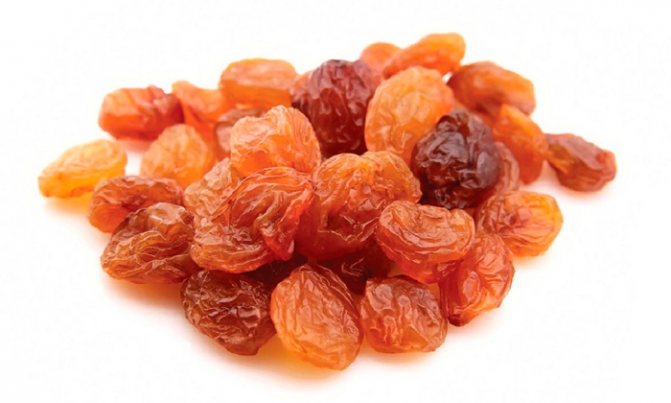
Raisins for diarrhea are indicated for both children and adults. Dried grapes have the ability to retain water, which allows you to quickly replenish fluid loss. At the same time, the product improves digestion and has some disinfecting properties.
Raisins are a source of rutin, ascorbic acid and potassium. And with diarrhea, it is most difficult to restore potassium loss. You only need a few berries, so the patient is not in danger of exceeding the carbohydrate limit.
If you have diarrhea, you can eat raisins even in dry form. A handful of berries is thoroughly chewed and washed down with a glass of warm water. This treatment is suitable even for the youngest patients. You can soak dried grapes before eating if dry raisins are difficult for your child to chew.
Raisin compote is prepared as follows:
- Soak 150 grams of berries for 1 hour, boil 1.5 liters of water and pour raisins with water. Place the saucepan with the drink on low heat and set aside after 15 minutes. After cooling, drink 100 ml every 4 hours.
- For a child, raisin compote for the treatment of diarrhea is prepared differently: 100 g of dried grapes are soaked for an hour and 1.5 liters of boiling water are brewed. Brew the drink for 20-30 minutes. It is recommended to add a small grated carrot. The compote is cooled, filtered and given to the baby every 2-3 hours, 50-80 ml.
Apples
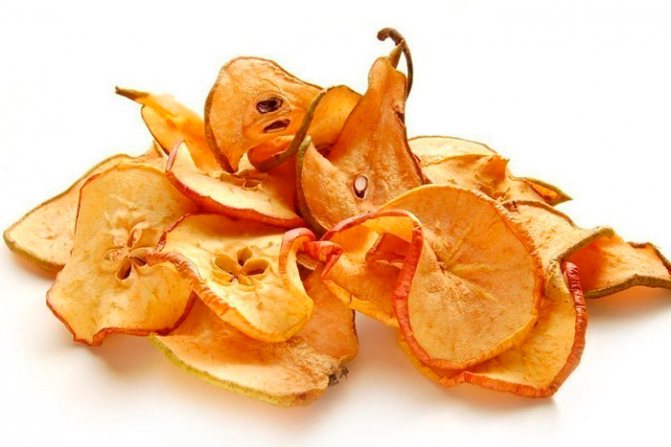
Dried apples are the best raw material for compote for diarrhea. The fruits contain a record amount of pectin, and plant fiber and fiber absorb toxins and help rid the intestines of poisons.
Important! To restore normal functioning of the intestines and stomach, it is recommended to eat dried fruits 2-3 days after the onset of diarrhea.
To treat children and adults, apple uzvar is prepared as follows: 300 g of dried fruits are poured into 2 liters of boiling water and simmered over low heat for 30 minutes. Then the drink is cooled and drunk warm or cool, 100-150 ml. The compote can be sweetened with a couple of teaspoons of honey.
Dried pears, plums, and apricots are added to uzvar. The additive should not exceed 40% of the weight of dried apples.
Dried apricots
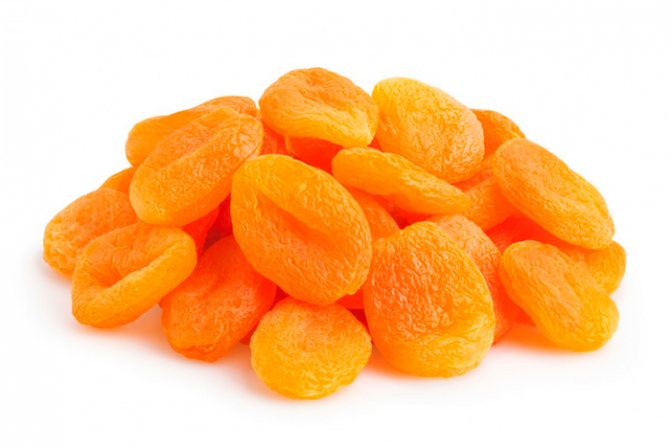
Dried apricots contain a very large amount of pectin and fiber, so they are used with caution for diarrhea. On the other hand, dried apricot infusion is an excellent source of potassium and vitamins and is very beneficial for dehydration.
Prepare a decoction of dried apricots as follows: 200 g of dried fruits are poured with 200 ml of boiled water and left for 1-2 hours. Then the fruits are poured into 1 liter of water, boiled and simmered over low heat for 20 minutes. To achieve complete release of vitamins into the water and dissolution of sugars, leave until completely cooled. Drink compote 4 times a day, 150 ml at a time.
